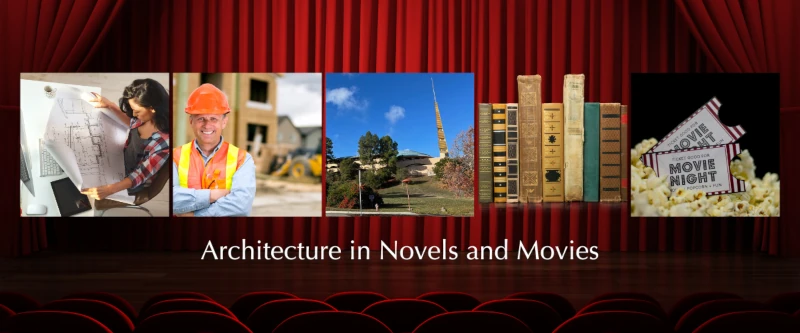Have you ever considered what architects, contractors and builders bring to novels and films?
The choice of a setting is crucial to storytelling.
Novels and movies often happen in a town or city that takes on the essence of a featured character. The Big Apple plays a role in so many novels in a variety of genres. From the gritty dark side of its mean streets to the bright lights of Broadway, New York becomes an essential character. The Alienist takes place in turn-of-the-century New York City. Caleb Carr was an historian who turned his talents to writing a mystery, so he infused the narrative with relevant details about the Gilded Age, adding depth and personality to the time and place. Looking back on this novel, we see reflections of a past repeating itself. The setting itself tells a story.
That is true of buildings, as well.
Imagine an entire movie taking place in essentially one room. Two movies come to mind, Room and Here. Room is about a woman and her child held captive in a shed, unable to venture outside. Here is a film that takes place almost entirely in the living room of a home built in colonial times in America. The story is told through the lives of the families that occupied the home over the years. Even the colonial mansion across the street plays a bit part.
Another film, Blade Runner, was influenced by the architecture of futurist Italian architect, Antonio Sant-Elia. Although he died in 1916, his architectural influences are still felt today. His architectural designs set the stage for the dystopian feel the movie conveyed. Interestingly enough, the architecture received nominations from the Golden Globes and the British Academy as well as the Academy Awards.
One movie’s title introduces the main character, The Grand Budapest Hotel. While they say that Ralph Fiennes led a 17-actor ensemble cast, the hotel itself feels more like the main character, enabling the story to be told. Set in a world torn by war and family conflicts, the hotel represents an elegant past evoking nostalgia and a desire for civility.
And who can forget the conflagration of The Towering Inferno? This burning building played a key role in highlighting the true cost of cutting corners when constructing a building with shoddy materials. Endless discussions about government regulations and oversight pale in comparison to the lurid, terrifying destruction of life and property portrayed in this film, giving all of us something to think about when it comes to where to save money during construction or remodeling projects.
Expanding our lens a bit, and getting closer to home, an outstanding character in the movie Gattaca is our very own Frank Lloyd Wright designed Marin Civic Center. The modern feel of this structure, built in the 1960s and 70s, gave the movie a futuristic ambience. Some designs feel timeless.
So, the next time you pick up a novel or go the movies, you might want to ponder the roles that setting and architecture play in conveying the story to its conclusion.
If you are considering how your dream home or a simple remodel can add to your story, contact AplosGroup today.


